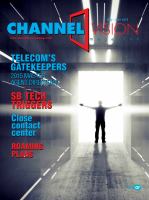

between vendors, developers and service providers.
As necessity is the mother of invention, let’s take a deep-
er look at why ICT infrastructure is evolving so quickly, and
then dive into how the relevant innovations are playing out
on a global scale.
Even if you are not all that keen on buzzwords, two that
have gained real substance in the past few years have been
“fast” and “agile.” For the purposes of this discussion, let’s
also throw “lean” into the mix.
In short, the most successful entities in the private sector
today tend to be the most agile, which allows them to become
quicker in their approaches to new trends and opportunities.
The lean aspect fuels agility and speed, as financial and opera-
tional restraints will be eased given the eradication of waste.
These are the firms that survive, and often thrive,
given the immense volatility of the global economy, as
well as the speed with which preferences and demands
change on a large scale.
Those trends mentioned in the beginning of this article
– globalization, enterprise mobility, the IoT, and big data –
have arguably come with the biggest impacts to the ways
in which enterprises and other organizations go about ICT
infrastructure provisioning. This is because they have among
the most complex network, storage, access, security, uptime,
and cost control demands.
Try to envision a small business in a rural area embracing
enterprise mobility with traditional ICT frameworks; we bet
you cannot, because it would not be possible. Cloud com-
puting, SDN, colocation and other advanced approaches to
ICT infrastructure have not only made it possible for most
entities to embrace enterprise mobility and other critically
important trends, but do so in a fast, agile and lean fashion.
Take public cloud as an example, which will generally be
an operational expenditure rather than a capital expendi-
ture, easing what would traditionally be massive strain on
budgets when a firm needed to overhaul its IT. Companies
also will almost always pay for only what they need, rather
than going overboard.
The speed with which public cloud solutions – includ-
ing IaaS – can be deployed in an organization once the final
contracts have been signed is also breathtaking. Whenever
the firm needs to adjust its provisioning, such as situations in
which demand either spikes or drops, it can do so with far less
trouble than trying to return or replace physical equipment.
The cloud strengthens corporate agility, efficiency and
speed for other reasons, while colocation data centers and
SDNs come with similarly positive impacts on these charac-
teristics of operations. With respect to those major trends
discussed above, these advanced infrastructure options fur-
ther improve a firm’s ability to embrace, optimize and capi-
talize on all of them.
Just as a note here, ICT is the crux because of how quickly
market competition has become rooted in the digital space.
This really only represents a minor part, but Statista ex-
plained that global ecommerce sales surpassed $1.2 trillion
in 2013 between business and consumers alone – not even
factoring in B2B. The segment of total gross domestic prod-
uct that digital commerce comprises is growing very fast and
is expected to accelerate further.
With the global economy seemingly moving in the right
direction, as well as the fact that another major recession
can strike at any time, there are so many opportunities and
risks out there today.
To capitalize on opportunities and mitigate risks in stride,
fast, agile and lean technologies are needed, and leading
players in ICT markets are making it happen.
Now, while all of the above assertions and explanations
should be enough to illustrate how complex, demanding and
rapidly evolving ICT infrastructure truly is, we did not even go
into other emerging trends. More efficient data center technol-
ogies that use renewables and minimize carbon footprints rep-
resent one major movement that is beginning to take shape.
Multi-tenant cloud computing environments are being
leveraged to reduce costs on an individualized basis, while
more valuable and rewarding colocation and interconnectiv-
ity environments are being erected by leaders in the field.
Add to this the fact that so many telecom companies and
others are beginning to migrate to SDN infrastructure, and
the direction in which the market is moving should be clear.
Telx’s latest strategies, objectives and achievements
represent how all of these matters are converging. Take,
for example, the 451 Research report on the company that
discussed Telx’s MarketplacePORTAL and other solutions,
as well as its improvements to service level agreements that
now guarantee 100 percent uptime and 24-hour cross-con-
nect provisioning.
This was made possible by the advancement of data cen-
ter, colocation and cloud computing facilities strategically
positioned in central commercial hubs. 451 Research’s Kelly
Morgan noted that Telx’s decision to start 2015 with two ex-
pansions in its leading market of New York will likely propel
it toward the expected 20 percent year-over-year revenue
growth this year.
This involved the Telx Trifecta of data center facilities –
NYC1 in Tribeca, NYC2 in Chelsea and NYC3 also in Tribeca,
which have dramatically increased the connectivity, power
and space it can now offer to clientele. These and other facil-
ities include densely interconnected meet-me room facilities
that help bring clientele together.
Furthermore, the Telx Cloud Xchange ecosystem of pub-
lic, private and hybrid cloud solutions, as well as managed
services, gives customers the edge when it comes to provi-
sioning, procurement and deployment.
In the coming years, businesses will need to ensure
that they are leveraging the most advanced, efficient, af-
fordable and powerful ICT infrastructure to survive and
thrive. Colocation, cloud computing, SDNs and other ad-
vanced data center options will be at the center of prog-
ress for years to come, regardless of whether trends tie
back to IT or telecommunications.
Anthony Rossabi is Executive Vice President of Market-
ing, Sales & Strategy at Telx.
27
May - June 2015 |
Channel
Vision
















